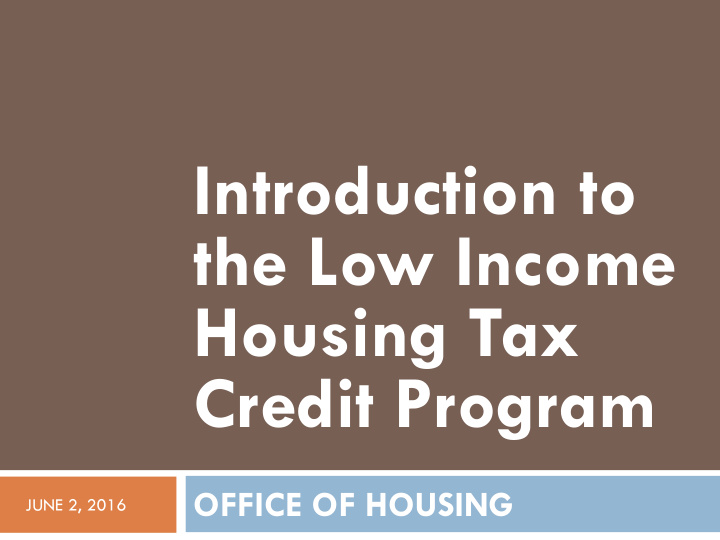



Introduction to the Low Income Housing Tax Credit Program OFFICE OF HOUSING JUNE 2, 2016
LIHTCs 101 Purpose and background Virginia Qualified Action Plan (QAP) Credit types How the program works The details Credit allocation timeline Challenges and opportunities Past and future projects
What is the LIHTC Program? The Low-Income Housing Tax Credit program is the federal government’s primary vehicle for assisting the development and preservation of affordable rental housing LIHTCs provide an infusion of private investor equity to affordable rental projects in exchange for an offset of the investor’s future tax liability Equity reduces the debt required to fund projects to enable landlords to charge rents affordable to households earning up to 60% of the area median income (AMI) Funds new construction and acquisition and rehabilitation
Who do LIHTC units serve? 2016 AMI (Area Median Income) Household 1-Person 2-Person 3-Person 4-Person Size/AMI ARHA/DCHS 30% AMI $22,850 $26,100 $29,350 $32,600 40% AMI $30,440 $34,760 $39,120 $43,440 Rental 50% AMI $38,050 $43,450 $48,900 $54,300 assistance Up to: 60% AMI $45,660 $52,140 $58,680 $65,160 80% AMI* $60,880 $69,520 $78,240 $86,880 Ownership assistance 100% AMI $76,100 $86,900 $97,800 $108,600 Sources: 2016 HUD Income Limits for 30% and 50% AMI for Washington-Arlington-Alexandria, DC- VA-MD HUD Metro Fair Market Rent Area); FY 2016 Multifamily Tax Subsidy Project Income Limits for 60% AMI; and Office of Housing for 40% AMI and Mathematical 80% AMI (figures have not been rounded) * Mathematical
A Little Background Part of the Internal Revenue Code (Section 42) Administered by state finance agencies Virginia Housing Development Authority (VHDA) Annual per capita allocation distributed through competitive process to eligible projects $2.35/per capita in 2016 In Virginia, approximately $19.7 million in per capita credits in 2016
Why is the Qualified Action Plan (QAP) important? Governs the allocation of available tax credits geographic distribution characteristics of eligible rental developments based on state preferences, priorities, and needs 2016 VA QAP: http://www.vhda.com/about/Planning- Policy/Pages/LIHTC-QAP.aspx#.Vz8_3PkrKUk Some changes anticipated in Fall 2016 Some items are discretionary to VHDA Director
Credit Types 9% (competitive) applied to eligible construction and “substantial” rehabilitation costs 4% tax credits (non competitive) applied to new construction and substantial rehab projects Must be paired w/tax-exempt bond financing May be used for acquisition of existing developments as long as the cost of rehabilitation is $10,000 or more per unit 4% and 9% credits can be combined
How LIHTCs work Developer “sells” credits to investor (or pool of Investors receive VHDA administers investors) to secure tax credit against and allocates 9% equity financing; future federal credits through enters into 15- taxes over 10 IRS issues credits competitive year limited years (current process based on partnership with pricing exceeds Qualified Action investor(s) with $1 in NoVA Plan opportunity to market) acquire property at end of compliance period
The details… Credits are calculated Costs included in the eligible based on “eligible basis” ≠ basis must be depreciable: Hard construction costs total development cost Soft costs (architectural and Projects compete in pools: engineering costs, developer fees, Pool type % construction loan interest) Non-profit 15% Non-depreciable costs that Local Housing Authorities 15% are excluded include: New Construction 15% Land Northern VA 18.02% Interest on permanent loans Northwest/North Central VA 9.2% Insurance and property Richmond 11.63% taxes Tidewater 17% Tax credit, relocation, and Balance of State 14.15% other fees
The details (continued) … Minimum threshold scores for 4% and 9% Cost caps for new construction and rehab New construction or adaptive reuse – $387,809/unit (+ up to an additional $43,090/unit if there is underground or structured parking) Acquisition/rehab: $338,564/unit Relocation assistance To be eligible for consideration, 20% of units must be at 50% AMI or 40% at 60% AMI Most projects are now 100% eligible Rents (commonly adjusted for utilities) are set at 30% of income Operating restrictions (affordability provisions) are in place for 30 years or more (voluntary)
Allocation Timeline Final rankings Allocation of Construction Reservation of Preliminary review and credits to be Applications Final rankings: credits and rankings: approved by accepted by completed due: March late May closing: early May VHDA Board: developer: within 2 years November June July of allocation
Challenges and Opportunities High cost of NOVA projects, including land and development site plan requirements, affect competiveness Rehab vs new construction Program preferences and priorities can be challenging and QAP can change Rental subsidies and deep affordability Special populations Other Limit to city funding Proposed federal legislation: Program name change to Affordable Housing Tax Credits Stabilize and increase 9% credit funding
Past Projects
9% (competitive) tax credit projects Project Name Owner Tax Credit Project Type Units Alexandria Crossing at Old Dominion ARHA 36 New construction/rehab Alexandria Crossing at West Glebe ARHA 48 New construction Beverly Park Wesley HDC 33 Rehabilitation Braddock / Whiting / Reynolds ARHA 48 New construction Chatham Square (former Samuel ARHA 52 New construction Madden Homes Downtown) Elbert Avenue CLI 24 out of 29 Rehabilitation Jackson Crossing AHC 78 New construction Old Town Commons (former James ARHA 134 New construction Bland) Pendleton Park ARHA 24 Acquisition/rehab Quaker Hill ARHA 60 Acquisition/rehab Station at Potomac Yard AHDC 44 out of 64 New construction
4% (non-competitive) tax credit projects Project Name Owner Tax Credit Project Type Units Alexandria Station Private 290 Rehabilitation Arbelo and Longview Apartments AHDC 75 Rehabilitation Brent Place Private 196 out of 207 Rehabilitation/ acquisition Fields of Alexandria Private 304 out of 306 Rehabilitation/ acquisition Fields of Old Town Private 98 Rehabilitation Lynhaven Apartments Wesley HDC 28 Rehabilitation/ acquisition ParcView Wesley HDC 120 out of 149 Rehabilitation/ acquisition Potomac West Private 45 out of 60 Rehabilitation/ acquisition
Future Projects St. James Plaza (approved during 2015 cycle) Gateway Apartments (competing in 2016 cycle) Carpenter’s Shelter Church of the Resurrection Ramsey Homes Future ARHA Redevelopment Projects
Panel Discussion
Questions?
Recommend
More recommend